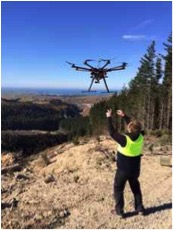
Swiss researchers have come up with AI that lets small quadcopters automatically identify and follow man-made trails in forests. Source: Gizmodo
They say it’s to help in search-and-rescue, but it also sounds like nanny state drones that could one day hunt me down in the woods as I dodge searchlights on my scramble toward sweet freedom.
A team from the University of Zurich, Dalle Molle Institute for Artificial Intelligence, and NCCR Robotics developed the tech, and published its research in the journal IEEE Robotics and Automation Letters.
They say that 1000 people go missing every year in forests and mountains in Switzerland alone, and many more the world over.
So the team wanted drones that complement rescue squads with cheap technology that can be mass-deployed quickly.
Flying around forests is actually super tough for UAVs, since it’s a more crowded, complex environment to operate drones than a tree-free cul-de-sac is, and identifying forest trails is even harder.
So the key was to develop software that uses a Deep Neural Network — in other words, a program that learns from its past mistakes to hone its future behaviour, just like humans do.
The researchers hiked for hours in the Swiss Alps and snapped over 20,000 images of trails using camera equipped helmets.
That data was used to create an algorithm. Next, the neural network was tested by being shown a new, never-before-seen trail — and the network was able to identify the trail as such on its own.
Using the algorithm, the software IDs visibly manmade trails and then steers the drone in the direction of the path.
The team says the deep neural network picked up on the trail 85 per cent of the time, while humans nailed it 82% of the time.
Now that drones can identify human-made trails, it’s a matter of time before they get better at ID’ing humans themselves — that could end up being a boon, or it could just be really creepy.







